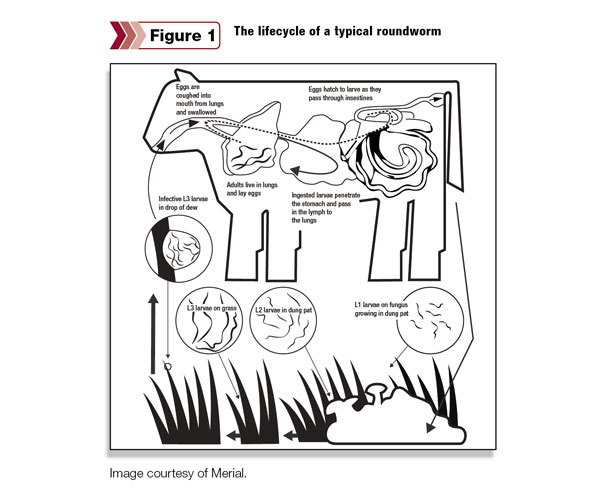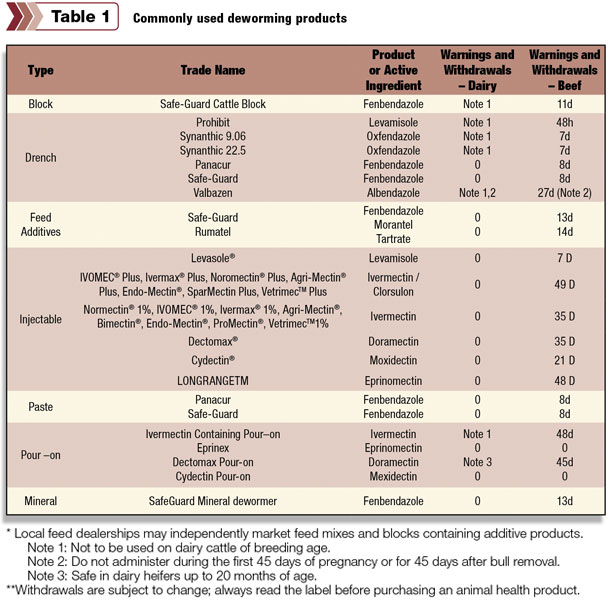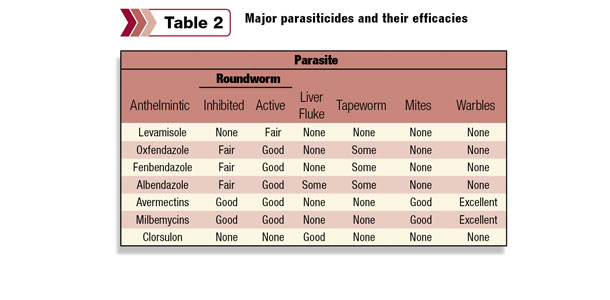However, there is increasing concern about the resistance of cattle parasites (anthelmintic resistance) to dewormers. Parasite presence is economically costly at much lower levels than previously thought.
Parasites in the absence of disease may cost the producer a large amount of money in lost weight gains and reduced feed conversion. Young animals like stockers and growers are more susceptible to parasite infection. Sick cattle or cattle in poor body condition are more prone to be infected with parasites.
Cattle may be infected with liver flukes, tapeworms or roundworms. Economic losses due to parasitic infections of livestock have been estimated at more than $2 billion annually in the U.S. These internal parasites can be controlled with proper management strategies, which should include a pre-planned deworming schedule.

The roundworm burden for many cattle is great enough to make deworming an economic benefit. Increased gains of up to 60 pounds per animal in a grazing season have been reported in some areas of the U.S.
A basic understanding of the life cycle of parasites can assist producers in making good management decisions when stocking young cattle on their operation.
The life cycle of all parasites involves both immature and mature stages. The animal harboring sexually mature parasites is called the principal host. Immature stages of some parasites must partially develop inside an animal of another species, such as an insect, a snail or another mammal.
These animals are called intermediate hosts. After such development, the immature parasite forms are infective for the principal host.
All tapeworms and flukes require intermediate hosts. These parasites are said to have indirect life cycles. Parasites that reproduce without an intermediate host have direct life cycles. Once infective parasite forms have entered the principal host, such as cattle, they grow to maturity.
The fluke’s life cycle requires two hosts: cattle and snails. Adult flukes are found in the bile ducts of cattle. Eggs are laid in the ducts and expelled with the feces. A larval stage hatches from the egg and infects the snail, where it reproduces asexually.
Specific stages of the juvenile fluke leave the snail and encyst on aquatic vegetation. Cattle eat the vegetation and become infected. The fluke migrates to the liver, infects the bile duct and matures into an adult.
Adult tapeworms have hooks, spiny structures or suckers on their heads, which allow them to attach to the wall of the intestine. The rest of the tapeworm is made up of a chain of flat segments.
The adult tapeworm consists of a head where the worm attaches itself to the mucosa of the intestine, a neck and a segmented body that contains both male gonads and female gonads.
Mature tapeworms shed segments, which are expelled with the feces. These segments are packed with eggs. The eggs are deposited on forage vegetation, which are eaten by cattle.
The segments enter the digestive tract of its intermediate host. The enzymes and the acids found in the gastrointestinal tract break down the protective barrier of each segment and release up to 100,000 eggs into the bovine system.
Maturation of roundworms to the adult stage requires approximately three weeks in cattle. During cool nights, these larvae stay at the base of grass near the ground. When sunlight warms the pasture, the larvae migrate up wet blades of grass to settle near the top, frequently swimming in drops of dew.
Winter weather does not destroy the entire larval population on pasture as was once believed. The larvae migrate into the soil or remain dormant under the snowpack until environmental conditions again become favorable for their development.
The growth of parasite larvae in the environment correlates very closely with grass growth in that the same conditions favor both.
Pasture management and anthelmintics (dewormers) are two methods now used to control internal parasites. Pasture management practices may reduce the parasite burden in cattle; however, this method alone will not guarantee parasite eradication.
Part of the nematode life cycle is on pasture. Pasture management methods designed to reduce third-stage larva populations include the following:
- Pastures grazed first in the fall and followed again in the spring will allow cattle to become infected with a greater roundworm burden than will pastures grazed first in the spring and then later in the fall.
For stocker cattle being placed on spring grazing, try to place cattle on a pasture that was not grazed the previous fall. Allow cattle to graze the pasture for only one period during the year.
If possible, move cattle in July to a pasture not grazed in the spring. This uses the principle of sunlight and drying to aid in decontamination of pasture areas by killing roundworm eggs and larvae.
- Pastures should be harrowed to break up manure pats only in the summer when it is hot and dry. Otherwise, harrowing simply scatters roundworm larvae and increases infection levels for grazing cattle.
Roundworms may survive in manure pats for up to 15 months if there has been no moisture to stimulate larval development by washing them away from the pats.
- Never follow a group of stocker-age calves with a group of sucking-age calves. The pasture will likely be heavily contaminated with roundworm eggs and larvae following the stocker calves. The younger calves will be very susceptible to larval infection while grazing.
- Alternating deworming products helps to reduce development of parasite resistance to individual drugs. Some drugs are much more likely to experience parasite resistance than are others.
- In feedlot situations, evaluate the source of the cattle and decide whether or not to deworm at entry into the feedlot. Based on that information, there is usually a benefit to deworming if cattle duration on the lot is around 90 days.
If cattle are kept beyond the 90-day limit, there is little benefit from deworming at entry. But cattle should be integrated into your regular parasite control practices if they remain on the farm.
- Treating subclinical parasitism at mid-season wastes time and money unless cattle are moved to a clean pasture immediately following treatment.
Anthelmintic control of parasites is another tool. Application of dewormers should not be aimed at treating infected cattle showing signs of parasitism. Instead, apply dewormers in a timely manner to reduce infection before symptoms of disease occur.
Treatment should also be aimed at interrupting the life cycle of the parasite in an effort to minimize pasture contamination. Many anthelmintic products are on the market. The following is a partial list of available products, trade names and active ingredients. See Tables 1 and 2.


The following categorization can be used as a general guide and adapted to your specific situation.
1. Mild incidence of parasitism
- Under normal circumstances, deworming is probably not of economic benefit. Deworm all cattle kept as replacements (at weaning) and deworm any cattle introduced onto the ranch. Ignore other animals in regard to deworming.
2. Moderate incidence of parasitism
- Cows: Deworm in the fall or spring (or mid-winter to incorporate fluke control).
- Calves: Deworm at weaning. (Do feeders only if you are keeping them or if you are getting paid by the buyer for deworming.)
- Stockers: Deworm at weaning (or acquisition). If stockers go onto wet meadows, deworm at three weeks after turnout.
3. Heavy incidence of parasitism:
- For cows, one of the following:
- Deworm at three and six weeks after turnout (or the beginning of grass growth) in the spring. (You can extend second deworming to eight weeks if Ivomec was used for the first treatment.)
- Deworm at weaning in the fall.
- Calves and stockers: Same as cows.
Jon Hogge is a University of Idaho Extension educator. ![]()







